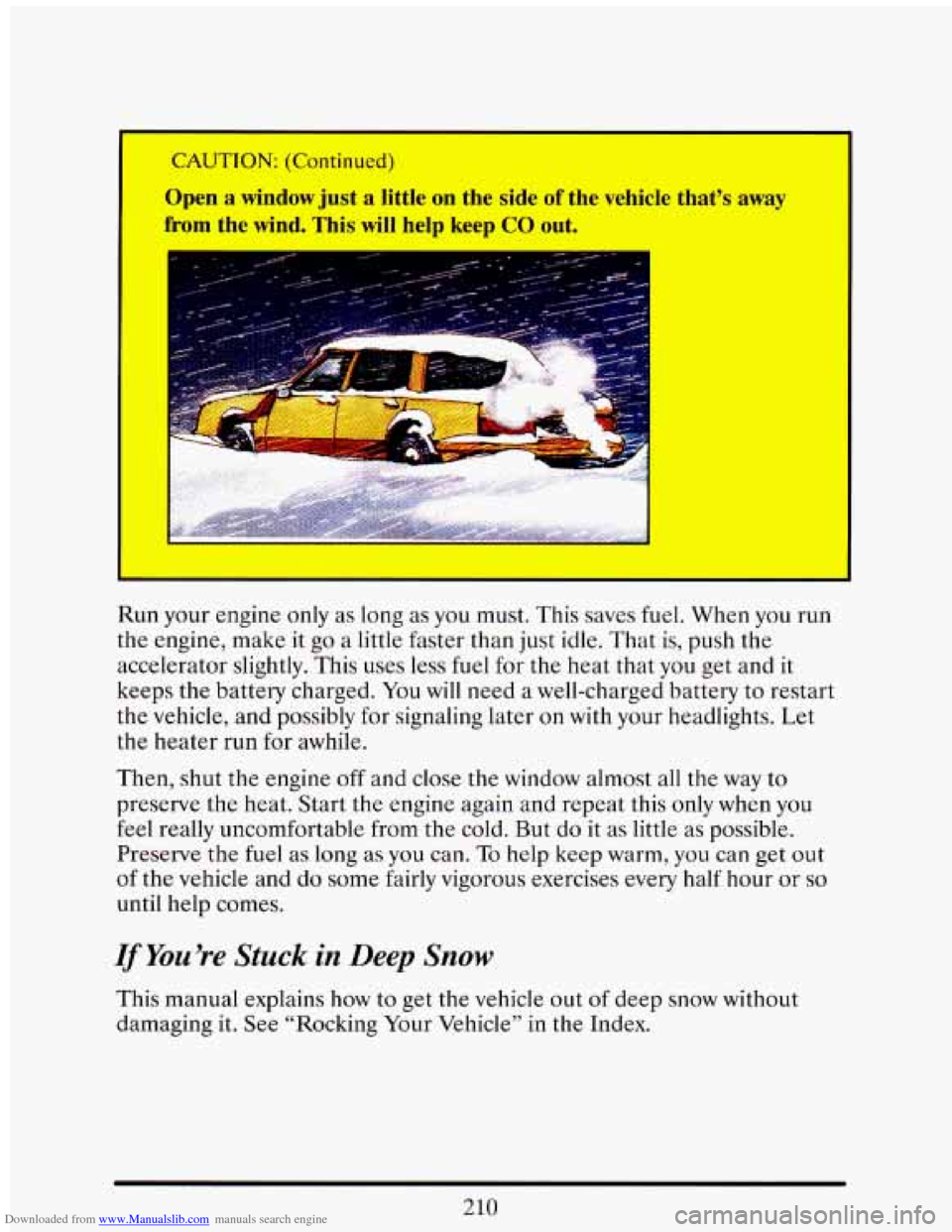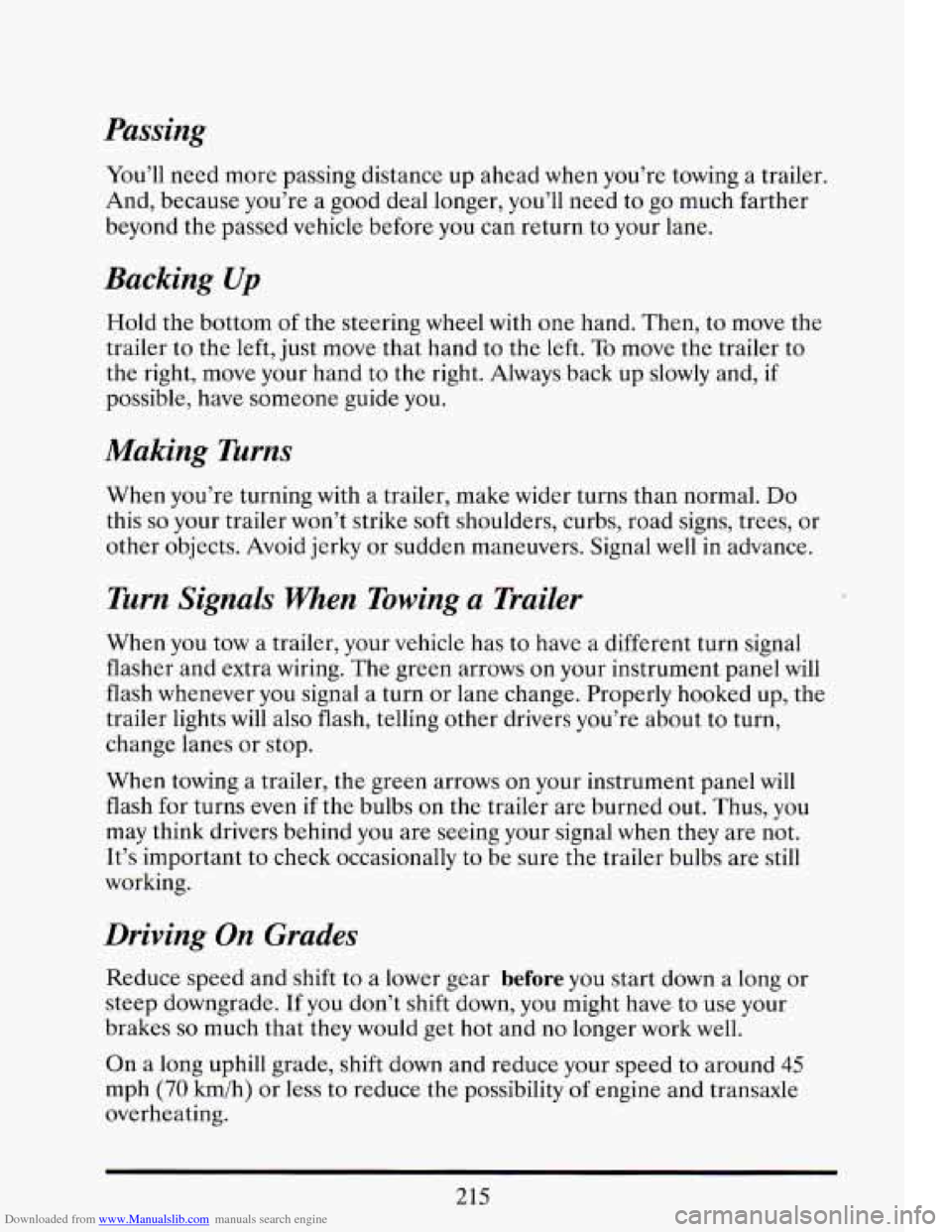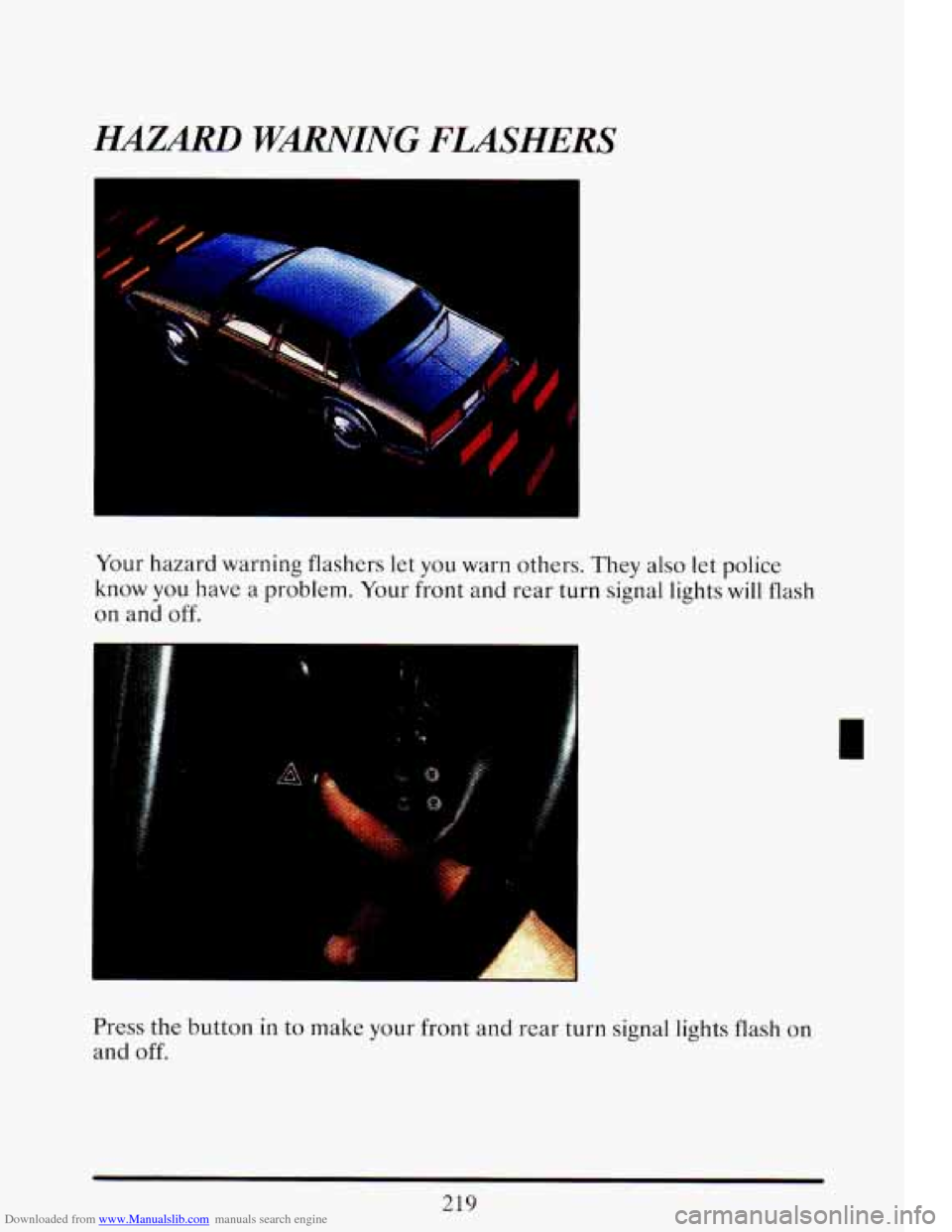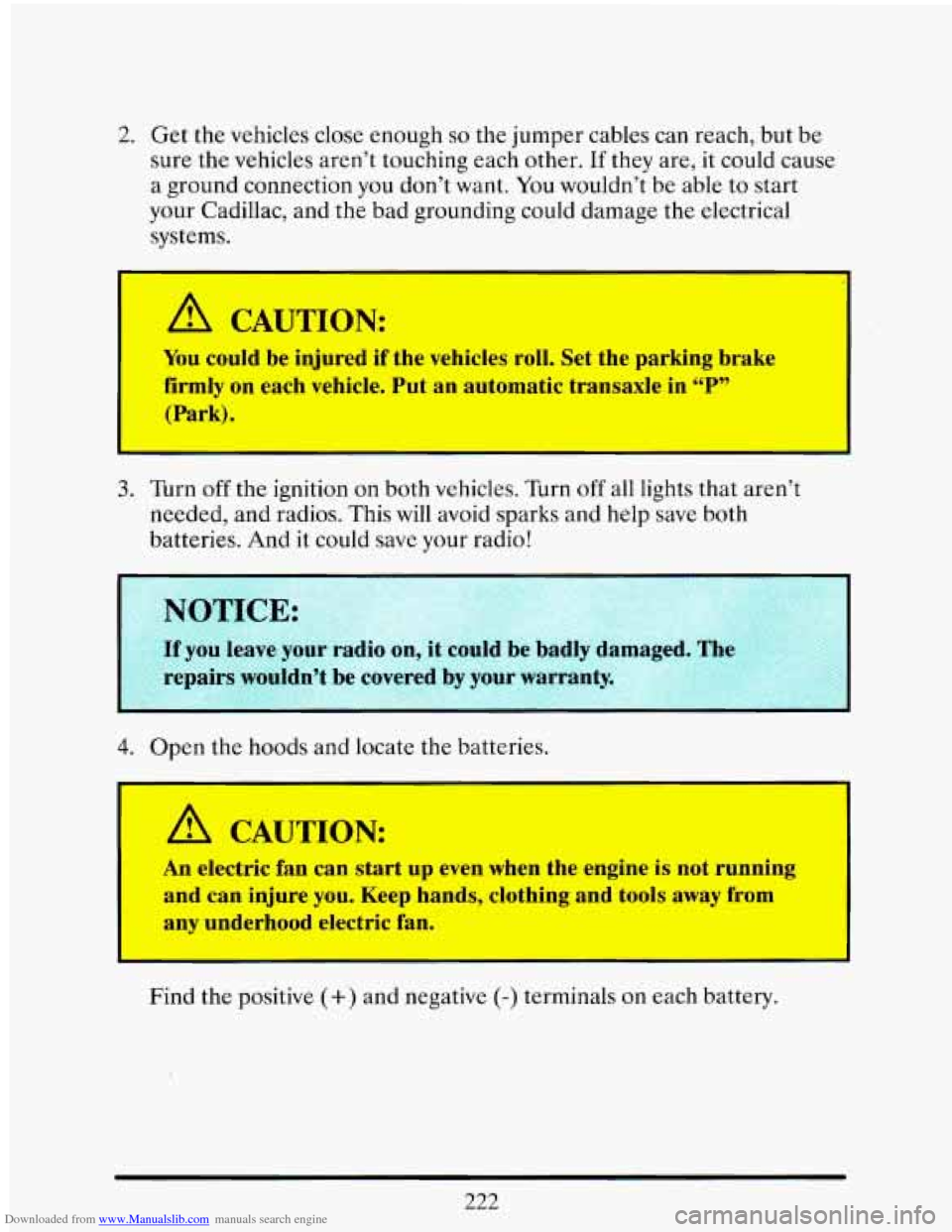1993 CADILLAC ELDORADO lights
[x] Cancel search: lightsPage 214 of 398

Downloaded from www.Manualslib.com manuals search engine 0
0
0
0
Lights: Are they all working? Are the lenses clean?
Tires: They are vitally important
to a safe, trouble-free trip. Is the
tread good enough for long-distance driving? Are
the tires all inflated
to the recommended pressure‘?
Weather Forecasts: What’s the weather outlook along your route?
Should you delay your trip a short time to avoid
a major storm
system?
Maps: Do you have up-to-date maps?
ON THE ROAD
Unless you are the only driver, it is good to share the driving task with
others. Limit turns behind the wheel
to about 100 miles (160 km) or two
hours at a sitting. Then, either change drivers or stop for some
refreshment like
coffee, tea or soft drinks and some limbering up. But do
stop and move around. Eat lightly along the way. Heavier meals tend to
make some people sleepy.
On two-lane highways or undivided multilane highways that do not have
controlled access, you’ll want
to watch for some situations not usually
found on freeways. Examples are: stop signs and signals, shopping centers
with direct access to the highway,
no passing zones and school zones,
vehicles turning left and right
off the road, pedestrians, cyclists, parked
vehicles, and even animals.
HIGWAY mPlVOSIS
Is there actually such a condition as “highway hypnosis”? Or is it just
plain falling asleep at the wheel? Call it highway hypnosis, lack
of
awareness, or whatever.
There is something about an easy stretch
of road with the same scenery,
along with the hum
of the tires on the road, the drone of the engine, and
the rush
of the wind against the vehicle that can make you sleepy. Don’t
let it happen to you! If it does, your vehicle can leave the road in less than
What
can you do about highway hypnosis? First, be aware that it can
happen. and
you could crash and be injured.
200
Page 224 of 398

Downloaded from www.Manualslib.com manuals search engine Open a window just a little on the side of the vehicle that’s away
from the wind. This will help keep GO out.
Run your engine only as long as you must. This saves fuel. When you run
the engine, make it go a little faster than just idle. That is, push the
accelerator slightly. This uses less
fuel for the heat that you get and it
keeps the battery charged. You will need a well-charged battery to restart
the vehicle,
and possibly for signaling later on with your headlights. Let
the heater run for awhile.
Then, shut the engine off and close the window almost all the way to
preserve the heat. Start the engine again and repeat this only when you
feel really uncomfortable from the cold. But do
it as little as possible.
Preserve the fuel as long
as you can. To help keep warm, you can get out
of the vehicle and do some fairly vigorous exercises every half hour or so
until help comes.
VYou’re Stuck in Deep Snow
This manual explains how to get the vehicle out of deep snow without
damaging
it. See “Rocking Your Vehicle’’ in the Index.
210
Page 228 of 398

Downloaded from www.Manualslib.com manuals search engine Safety Chains
You should always attach chains between your vehicle and your trailer.
Cross the safety chains under the tongue of the trailer
so that the tongue
will not drop to the road
if it becomes separated from the hitch. Follow
the manufacturer’s recommendation for attaching safety chains. \
Always
leave just enough slack
so you can turn with your rig. And, never allow
safety chains
to drag on the ground.
Trailer Brakes
Does your trailer have its own brakes? Be sure to read and follow the
instructions for the trailer brakes
so you’ll be able to install, adjust and
maintain them properly.
Because you have anti-lock brakes, do not try to tap into your vehicle’s
brake system. If you do, both brake systems won’t work well, or at all.
Driving with a Trailer
Towing a trailer requires a certain amount of experience. Before setting
out for the open road, you’ll want
to get to know your rig. Acquaint
yourself with the feel of handling and braking with the added weight
of
the trailer. And always keep in mind that the vehicle you are driving is
now a good deal longer and not nearly so responsive as your vehicle is by
itself.
Before you start, check the trailer hitch and platform, safety chains,
electrical connector, lights, tires and mirror adjustment.
If the trailer has
electric brakes, start your vehicle and trailer moving and then apply the
trailer brake controller
by hand to be sure the brakes are working. This
lets you check your electrical connection at the same time.
During your trip, check occasionally to be sure that the load is secure,
and that the lights and any trailer brakes are
still working.
Following Distance
Stay at least twice as far behind the vehicle ahead as you would when
driving your vehicle without a trailer. This can help
you avoid situations
that require heavy braking and sudden turns.
214
Page 229 of 398

Downloaded from www.Manualslib.com manuals search engine Passing
You’ll need more passing distance up ahead when you’re towing a trailer.
And, because you’re a good deal longer, you’ll need
to go much farther
beyond the passed vehicle before you can return to your lane.
Backing Up
Hold the bottom of the steering wheel with one hand. Then, to move the
trailer to the left, just move that hand to the left.
To move the trailer to
the right, move your hand to
the right. Always back up slowly and, if
possible, have someone guide you.
Making Turns
When you’re turning with a trailer, make wider turns than normal. Do
this so your trailer won’t strike soft shoulders, curbs, road signs, trees, or
other objects. Avoid jerky or sudden maneuvers. Signal well
in advance.
Turn Signals When Towing a Trailer
When you tow a trailer, your vehicle has to have a different turn signal
flasher and extra wiring. The green arrows on your instrument panel will
flash whenever
you signal a turn or lane change. Properly hooked up, the
trailer lights will also flash, telling other drivers you’re about to turn,
change lanes or stop.
When towing a trailer, the green arrows on your instrument panel will
flash for turns
even if the bulbs on the trailer are burned out. Thus, you
may think drivers behind you are seeing your signal when they are not.
It’s important to check occasionally to be sure the trailer bulbs are still
working.
Driving On Grades
Reduce speed and shift to a lower gear before you start down a long or
steep downgrade.
If you don’t shift down, you might have to use your
brakes
so much that they would get hot and no longer work well.
On a long uphill grade, shift down and reduce your speed to around
45
mph (70 km/h) or less to reduce the possibility of engine and transaxle
overheating.
215
Page 233 of 398

Downloaded from www.Manualslib.com manuals search engine HAZARD WMING FLASHERS
.
Your hazard warning flashers let you warn others. They also let police
know you
have a problem. Your front and rear turn signal lights will flash
on and
off.
Press the button in to make your front and rear turn signal lights flash on
and off.
219
Page 236 of 398

Downloaded from www.Manualslib.com manuals search engine 2. Get the vehicles close enough so the jumper cables can reach, but be
sure the vehicles aren’t touching each other.
If they are, it could cause
a ground connection
you don’t want. You wouldn’t be able to start
your Cadillac, and the bad grounding could damage the electrical
systems.
-
A CAUTION:
You could be injured if the vehicles roll. Set the parking brake
firmly on each vehicle. Put an automatic transaxle in
“P”
‘”ark).
-
3. Turn off the ignition on both vehicles. Turn off all lights that aren’t
needed, and radios. This
will avoid sparks and help save both
batteries. And it could save your radio!
4. Open the hoods and locate the batteries.
A CAUTION:
An electric fan can start up even when the engine is not running
and can injure you. Keep hands, clothing and tools away from
any underhood elc ric fan.
Find the positive
(+) and negative (-) terminals on each battery.
222
Page 294 of 398

Downloaded from www.Manualslib.com manuals search engine made especially for your automatic transaxle. Damage caused by fluid
other than DEXRON@-IIE is not covered by your
new vehicle warranty.
After adding fluid, recheck the fluid level as described under “How to
Check.”
When the correct fluid level is obtained, push the dipstick back in all
How To Reset Transaxle Fluid Change Indicator: (4.6 Liter Northstar)
Your vehicle is equipped with
a transaxle fluid change indicator. A
“CHANGE
TRANS FLUID’’ message will display on the Information
Center when the power train computer determines that the transaxle
fluid needs to be changed or at each 100,000 miles (160,000
km) interval,
whichever occurs first. When this message appears, change the transaxle
fluid and reset
the transaxle fluid life indicator as follows:
the
way.
0 Turn the key “ON” with the engine stopped.
Press and hold the “OFF” and “REAR DEFOG” buttons on the
climate control simultaneously until the
“TRANS FLUID RESET”
message appears
in the Information Center (between 5 and 20
seconds).
ENGINE COOLANT
The following explains your cooling system and how to add coolant when
it
is low. If you have a problem with engine overheating, see “Engine
Overheating” in the Index.
The proper coolant for your Cadillac will:
Give freezing protection down to -34” F (-37” C) .
0 Give boiling protection up to 262OF (128O C) .
0 Protect against rust and corrosion.
Help keep the proper engine temperature.
Let the warning lights work as they should.
What to Use:
Use a mixture of one-half clean water (preferably distilled) and one-half
antifreeze that meets “GM Specification 1825-M,” which won’t damage
aluminum parts. You can also use a recycled coolant conforming to
GM
280
Page 308 of 398

Downloaded from www.Manualslib.com manuals search engine HLOGEN BULBS
I
LAUTION:
Halogen bulbs have pressurized gas inside and can burst if you
drop or scratch the bulb.
You or others could be iniured. Take
handling and disposing
of h
WP HOUSINGS
Your Cadillac's lamp housings are designed with small vents so moisture
will be removed when the lights are on,
or after driving for a short time.
HEADLIGHT BULB REMOVAL
The following procedurc tells you how to removc the halogen headlight
bulb. Follow either the
EXPORT or DOMESTIC illustration that best
describes your vehicle.
To remove the cover,
turn lock tabs in the
direction
of arrows
. 'V
shown on the cover.
Lift
the cover up to
gain access.
294